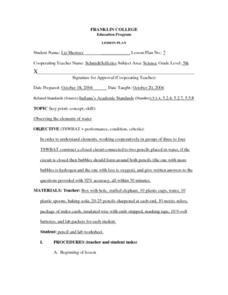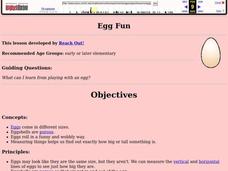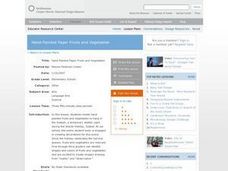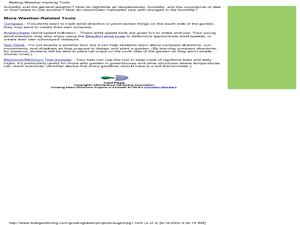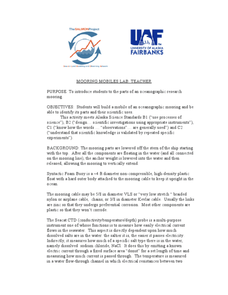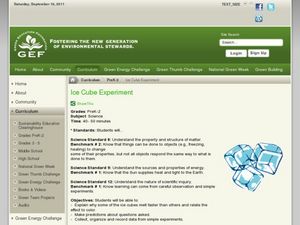Curated OER
Nature Notes
Students spend some time outdoors and record their observations of abiotic conditions, geologic surroundings and living organisms. They reflect and write about the experience of being observant in nature.
Curated OER
Help Save the Polar Bear
Students use ice cubes to demonstrate how the polar ice caps are melting and how it effects the polar bears. In this polar bear lesson plan, the teacher explains how polar bears live on the north pole and how they are having trouble due...
Curated OER
Observing the Elements of Water
Fifth graders conduct a closed circuit experiment to observe the elements of water. They discuss the elements of Hydrogen and Oxygen, and in small groups construct a closed circuit connected to two pencils placed in water. Students...
Curated OER
Wind
Students complete activities to study wind intensity. In this wind study lesson, students discuss wind speed and direction. Students then build a kite and windsock to help them study wind intensity. Students learn to use a wind meter for...
Curated OER
What does it mean to be a citizen?
Students examine democracy and the role of a citizen. They contrast rights and responsibilities of individuals, groups, and organizations. Students identify two forms of democratic action and describe demoncratic values. Students observe...
Curated OER
Egg Fun
Students complete experiments to find out if all eggs are same size, how they roll, and where is the air inside of the egg.
Curated OER
CLASSROOM MAPS
Pupils do a blind tour of their school by responding to verbal commands. They look and discuss various maps in the classroom. They locate the direction of the sunrise and discuss the compass directions of North, South, East, and West.
Curated OER
Look at Those Leaves!
Students observe leaves. In this math and science cross-curriculum leaf lesson, students take a nature walk and collect leaves. Attributes are assigned and leaves are sorted in various ways. Students use non-standard or standard units of...
Curated OER
What Orbital Dynamic Variables are Responsible for Earth's Weather?
Students explore the changing of the seasons. In this astronomy and seasons instructional activity, students construct a model of the revolution of the sun and the moon. Students compare the recorded solstice/equinox orbital positions...
Curated OER
What on Earth is That and How Can I Get One?
Students examine how we use submersibles. In this technology based lesson, students examine various technologies used by submersibles in ocean exploration.
Curated OER
WHAT DARWIN NEVER SAW: Evolution, Science, Biology, Natural Selection
Students view video showing recent field work on a twenty two-year study of finch beaks on a small island in the Galapagos, showing natural selection clearly operating in the wild.
Curated OER
What's the Matter? (Grade 3)
Third graders organize information about the three types of matter and to reinforce concepts learned in the matter unit of the science curriculum. They use Inspiration software to create a concept map of the three types of matter.
Curated OER
What's In Your Stream?
Students conduct hands-on fieldwork in order to investigate water quality of a nearby stream. They discuss watersheds and how it affects water quality as well as identify any causes of changes or pollution in the area water before...
Curated OER
Hand-Painted Paper Fruits and Vegetables
First graders create hand painted fruits and vegetables to hang in the Sukkah, a temporary shelter used during the Jewish Holiday, Sukkot. They are excited about the creation of the works of art and the lesson engagement is high being...
Curated OER
Making Weather-Tracking Tools
Young scholars build tools to help track the weather. In this weather lesson plan, students follow directions to build a rain gauge, barometer and hair hygrometer.
Curated OER
Seasons Worksheet #2
A tilted Earth is shown in relation to the rays of light from the sun. Earth science superstars determine latitude, month, and time of day. They compare number of daylight hours for different points on Earth. The five multiple choice...
Curated OER
Mooring Mobiles Lab
Oceanography experts use candy to construct a model of a bio-physical mooring that would test a variety of factors. Each piece of equipment to be included on the mooring is described within the write-up. As pupils gather the candies for...
Curated OER
Johnny Appleseed
Students engage in a study of apples using children's literature. They conduct research using a variety of resources. Student list facts about apples and compare them while answering some guided questions. They plant some apple seeds and...
Curated OER
Concepts of Beauty Put Into Words
Studying haiku poetry with your English class? Delving into Japanese history with your world history class? Here is an authentic and creative way to explore Japanese culture more deeply. Pupils will compare and contrast two tea caddies...
Curated OER
Soil Porosity, Moisture Content, pH, and Density
This lab activity does not have to be done with AP environmental scientists. It can also be done with middle to high school earth scientists. The procedures aren't complex. Learners determine the density of dry and wet sand in order to...
Curated OER
Order Numbers On a Number Line
Fifth and sixth graders study the use of a number line to add integers and they observe a teacher demonstration of how to add integers on a number line. Afterward, they construct a number line and use the number line to solve addition...
Curated OER
Orbits Worksheet #2
Brief, but beneficial, this resource draws space scientists into the orbit of a moon around its planet. Assignees answer five multiple choice style questions using a diagram of the planet, the moon's orbit, its focal points, and the...
Curated OER
Ice Cube Experiment
Students explore the rate at which ice melts. In this science lesson, students place ice cubes on colored index cards and place them in direct sunlight. Students observe which ice cubes melt fastest and slowest.
Curated OER
What's Going to Happen at Any Given Barometer Reading?
Fourth graders brainstorm a list of words associated with weather. In groups, they sort the words into categories and observe the weather in their area for a month. To end the lesson, they compare the barometer measurements for a...




